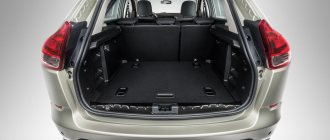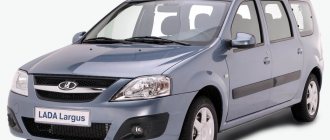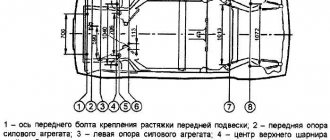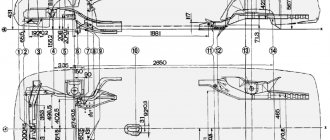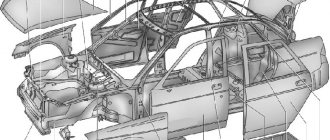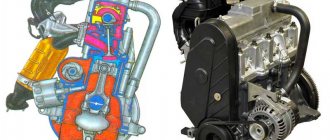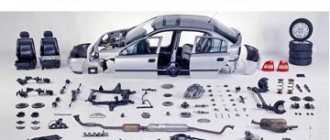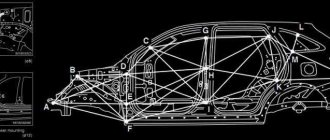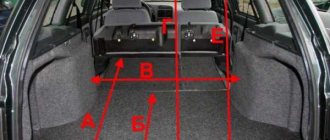The VAZ 2114, produced in a pilot batch of fifty copies in 2001, was put on the assembly line and became available to the average motorist in 2003. It was created on the basis of the old VAZ 2109; in comparison with it, the fourteenth model received a radical update.
The design became more modern and pleasant, the bumpers began to be painted in body color, moldings and sill fairings appeared. The interior trim has also changed: an adjustable steering column, a Euro instrument panel, a steering wheel from a VAZ 2110 and a new heating system.
But the most important thing is in the engines. Starting with the VAZ 2114, the carburetor intake became a thing of history; it was finally replaced by an injector with distributed fuel injection. This made it possible to achieve greater efficiency and at the same time improve dynamic characteristics.
The car also has many additional options that were previously unavailable. Such as: tinted windows, power windows, heated seats, fog lights, alloy wheels and central locking.
The VAZ 2114 was produced in two trim levels:
- Luxury
- Standard.
The Luxury version came pre-installed from the factory with fog lights, wheel caps, head restraints for rear passengers, and modified upholstery on the doors and door trims. The main advantage of the highest configuration was the trip computer, which could record fuel consumption, average speed, travel time and other interesting parameters.
In 2007, the VAZ 2114 model received a restyling, a new engine and index 21144. With this internal combustion engine, the car began to comply with the EURO-3 environmental class. A plastic decorative cover appeared, the aluminum receiver was replaced with a plastic one, and the catalyst was moved closer to the engine. In addition, small changes have occurred inside the car.
The dashboard was updated, the upper glove compartment disappeared, an on-board computer was integrated into the instrument panel, showing the voltage in the on-board network, outside temperature, time, and the like.
Characteristics of VAZ 2114
The following performance characteristics are declared from the factory for the VAZ 2114:
- number of seats: 5;
- recommended fuel: AI-95;
- maximum speed: 165 kilometers per hour;
- fuel consumption: 8.9 l per 100 km in the city;
- acceleration time to 100 kilometers per hour: 13 seconds;
- gas tank volume: 43 l;
- engine location: front, transverse;
- weight: 970 kilograms;
- fuel system: distributed injection;
- trunk volume: 427 l;
- drive: Front.
| The length of the car is the distance between the front and rear bumper. Often car owners install towbars on their cars, which in turn makes your car longer. The width of the car is the distance between the side mirrors. And the height of the car will be equal to the tallest part of your car. Be it its roof, antenna or spoiler. The overall dimensions of the VAZ 2114 are shown in Figure 1. Figure 1 - Overall dimensions of the VAZ 2114. Cars differ from each other in many ways. These parameters are usually called technical characteristics. They are indicated by auto manufacturers for all brands and models of manufactured cars. Comparing technical characteristics is the easiest way to compare different cars with each other. This section contains technical characteristics of cars: both new and those that have been on the market for a long time. By selecting the make and model of a car, you can view its detailed characteristics. Technical specifications include:
Recently, for most citizens, a personal car has turned not only into a means of transportation, but also into a certain attribute that shapes the image of a person. It is for this reason that most manufacturers have entered into a race for the “best” car design. Increasingly, in car advertising, the emphasis is on innovative, sporty, stylish, feminine, brutal or simply modern design, and the previously dominant technical characteristics fade into the background. Technical characteristics of the VAZ 2114 are presented in Table 2 Table 2 - Technical characteristics of the VAZ 2114. Car modifications | |
| Engine | |
| Engine location | Front longitudinal |
| Engine capacity | |
| Number of cylinders / Valves per cylinder | |
| Piston stroke | |
| Cylinder diameter | |
| Compression ratio | |
| Supply system | Electronically controlled distributed injection |
| Power (hp/rpm) | |
| Torque (Nm/rpm) | |
| Fuel type | |
| Transmission | |
| Wheel formula / drive wheels | 4X2 / front |
| Transmission | mechanical |
| Number of gears | 5 forward, 1 reverse |
| Steering | |
| Amplifier | |
| Brake system | |
| Front brakes | Disk |
| Rear brakes | Drums |
| Suspension | |
| Front suspension type | Shock absorber |
| Rear suspension type | Trailing arm |
| Body type / number of doors | Hatchback / 5 |
| Number of seats | |
| Wheelbase | |
| Front wheel track, mm | |
Thanks to its technical characteristics and appearance, the VAZ 2114 car has gained great popularity among people of different ages. Adults appreciated the large trunk, folding seats, and low fuel consumption. And young people bought it for its good dynamics and more modern design, both external and internal.
The dimensions of the VAZ 2114 correspond to international class B.
In raw numbers they look like this:
- Machine length: 4100 mm.
- Machine height: 1415 mm.
- Machine width: 1620 mm.
- Base: 2460 mm.
- Ground clearance: 165 mm.
- Rear track: 1370 mm.
Models with index 211440-24, produced in 2007, and 211440-26, which appeared on production lines in 2010, had slightly modified dimensions 2114:
- Machine length: 4122 mm.
- Machine height: 1402 mm.
- Machine width: 1650 mm.
The differences were due to the restyling of the bumpers, rear-view mirrors, as well as minor adjustments to the car’s suspension.
Some people want to increase the ground clearance of the VAZ 2114, then the car will have more cross-country ability and will be easier to overcome city obstacles. But an increase in ground clearance has a negative impact on the location of the car’s center of mass; in corners it will become more rolly and generally lose controllability. Everyone chooses what is more important to them.
The volume in liters is the same as in cubes (cubic decimeters).
This capacity of the machine allows it to transport even large cargo, which is especially important for those who often face the need to deliver any goods or cargo for other purposes to the unloading point. With the seats folded down, the trunk volume almost doubles.
In addition, if you need to transport a large amount of cargo, or, for example, you are going on a trip with the whole family, you do not have to be limited to 330 liters of space for storing things. Various fastenings and installations are available for sale for this car model, which allow you to transport much more things than will fit in the luggage compartment.
For example, you can install a roof rack. Various options for such mounts are available for sale:
- Autoboxes.
- Fastenings for sports equipment.
- Baskets.
- Expeditionary roof racks.
Thus, you will be able to make your car even more spacious and free up space for passengers.
Button control
It is very convenient when control (opening the trunk) is carried out from a button. Every car owner knows that it is very important to ensure that the trunk, like the car doors, closes securely. Reliable operation of trunk locks is just as important as the reliability of the lock on a garage or apartment door. All modern car models are equipped with a trunk opening mechanism using a control panel or a special button. Installing a mechanism with a button not only makes control more convenient, but also solves a number of problems. In particular, this solves the problem of icing of the lock, which is opened with a key.
VAZ cars, 2113, 2114 and 2115 are models that are popular among domestic drivers. This is due to their low cost, maintainability, relative reliability and unpretentiousness. And the practicality of using the car depends on the volume of the trunk of the VAZ 2114.
VAZ 2113
Thanks to the trunk volume of the VAZ 2113, drivers have the opportunity to transport large cargo. Its capacity is 330 liters. The technical characteristics of the luggage compartment make it possible to transport items of non-standard sizes.
The trunk of the 2113 model is transformable: the driver can remove the shelf and fold down the rear seats. After this, its capacity is 632 liters. The hatchback allows you to transport small and long cargo.
Disadvantages include the lack of standard lighting (when tuning a car, you install it yourself), a high loading side, which makes it difficult to place cargo inside.
VAZ 2114
VAZ 2114 is a reliable five-door car. The capacity is 330 liters with the seats folded down, and with the seats folded down it is equal to 632 liters. The loading height of the side has an inconvenient level (similar to that used on the thirteenth model), which significantly complicates the loading process.
The dimensions of the trunk are as follows: length - 830 millimeters with the seats folded and almost 1660 millimeters with them unfolded, width - 935 millimeters, depth - 830 millimeters, height - 780 millimeters. These dimensions are approximate and are valid for models 2113 and 2114.
Transformation capabilities allow you to load items whose length and dimensions differ from standard dimensions. When installing additional luggage structures on the roof, you can transport a certain amount of large cargo.
The capacity, expressed in liters, is identical to the volume, which is indicated in cubic decimeters.
VAZ 2115
The trunk volume of the VAZ 2115 is 427 liters with the seats folded down; if they are unfolded, the capacity increases to 700 liters. The dimensions of the luggage compartment have been increased, thanks to which even large-sized cargo can be transported on the fifteenth model.
The advantages include ease of dismantling, installation of a shelf, as well as a convenient height for loading. It is located almost at the level of a car bumper.
Drivers often improve sound insulation and standard luggage compartment lining. They install an electric drive for opening the lid, install lighting, and construct boxes for storing small items (however, due to their installation, the trunk significantly loses volume).
Trunk Features
The features of the luggage compartments of various modifications of models 2113, 2114, 2115 include an acceptable level of capacity and the possibility of transforming the interior to increase useful volume.
The VAZ 2115 is distinguished by a convenient loading height and a larger trunk volume than the Lada 2115. Otherwise, the design of the cargo compartment is identical to other models.
Cars are equipped with a standard shelf; it is installed vertically and separates the luggage compartment and the interior. If necessary (for example, when transporting large cargo that requires folding the rear seats), this shelf and the vertical curtain can be removed.
On Lada 2113, 2114, 2115 cars, under the “floor” of the trunk there is a niche for storing a spare wheel and tools necessary for quickly repairing small faults that may arise along the way.
The VAZ 2115 is distinguished by a convenient loading height and a larger trunk volume than the Lada 2115. Otherwise, its design is identical to other models.
The VAZ 2113, 2114, 2115 models, which are modifications of the “eights”, “nines” and “ninety-nines”, respectively, have become more ergonomic, easy to use, and practical. The cars received spacious luggage compartments, which increased the amount of cargo transported. The presence of a number of shortcomings does not deter drivers: some inconveniences can be corrected on their own.
Cars of the VAZ 2113, 2114, 2115 family are popular not only in Russia, but also in the CIS countries. This is due to the wide distribution of these cars, their unpretentiousness, relative reliability, maintainability and cost. The machines have an acceptable loading niche capacity, which makes them convenient to use for solving everyday household problems or running a small business.
infokuzov.ru
Trunk volume of VAZ 2114
Generation 1st generation Series Select Hatchback 5-door Modification Select 1.5 MT (77 hp) 1.6 MT 8 cl. (Euro-3) (81 hp.) 1.6 MT 16 cl. (89 hp.) 1.6 MT 16 cl. ( 98 hp)1.6 MT 8 cl (Euro-4) (81 hp)
Update
VAZ (Lada) 2114 1st generation 1.5 MT (77 hp)
- Trunk volume minimum 427 l
- Maximum trunk volume 427 l
VAZ (Lada) 2114 1st generation 1.6 MT 8 cl (Euro-3) (81 hp) VAZ (Lada) 2114 1st generation 1.6 MT 16 cl (89 hp)
- Trunk volume minimum 300 l
- Maximum trunk volume 632 l
VAZ (Lada) 2114 1st generation 1.6 MT 16kl (98 hp)
- Trunk volume minimum 300 l
- Maximum trunk volume 632 l
VAZ (Lada) 2114 1st generation 1.6 MT 8 cl (Euro-4) (81 hp)
- Trunk volume minimum 300 l
- Maximum trunk volume 632 l
wikidrive.ru
Trunk volume of VAZ-2114: dimensions and exact parameters
VAZ-2114 is a car that replaced the discontinued “Nine”, and immediately gained popularity and became in demand. Compared to its predecessor, this car model has several differences. The differences affected not only the external parts of the body, but also the interior. In particular, the VAZ-2114 has a large trunk volume. Door sill trims, moldings along the sides, a spoiler with a brake light - all this gives the car a modern appearance.
External changes affected the performance characteristics of the machine. In particular, this model has excellent aerodynamic qualities. It is stable on the road, even when driving at high speed. The combination of body colors and attached parts gives this car the appearance of a foreign car.
Thanks to its appearance, this car has aroused increased interest among people who are involved in tuning. At relatively low financial costs, such a car can easily be made into an original car that stands out from the crowd, thereby emphasizing the individuality and sense of style of its owner.
Trunk
Due to the ability to fold the rear seat, this car can easily be transformed into a utility vehicle. For this car model, the trunk volume is:
- 330 dm3 with seats folded down;
- 600 dm3 with rear seats folded.
Body geometry of the VAZ 2114 and its meaning
Violations of the body geometry have certain consequences, which are reflected in the general condition of the car in the following ways:
- Deterioration in controllability and vibration when accelerating (manifests itself at 80 km/h and above).
- Increased tire wear.
- Noise from suspension elements.
- Increased fuel consumption, etc.
The VAZ 2114 has a hatchback body type, for which, however, as for other types (station wagon, sedan, etc.), violation of the geometry affects various parameters.
The symmetry of the wheels is broken, as can be judged by:
- reducing vehicle stability on the highway;
- uneven tire wear.
The diagonals of the body are broken, which is noticeable in the frames of the front/rear windows and in the doorways of the car.
Specific folds may form on the bottom or frame.
For cars that are used for a long time on roads of poor quality, it is recommended to periodically check the geometry of the body (at least 1-2 times a year).
We clarify the dimensions of the VAZ 2114 | VAZremont.com
The VAZ 2114, produced in a pilot batch of fifty copies in 2001, was put on the assembly line and became available to the average motorist in 2003. It was created on the basis of the old VAZ 2109; in comparison with it, the fourteenth model received a radical update.
The design became more modern and pleasant, the bumpers began to be painted in body color, moldings and sill fairings appeared. The interior trim has also changed: an adjustable steering column, a Euro instrument panel, a steering wheel from a VAZ 2110 and a new heating system.
But the most important thing is in the engines. Starting with the VAZ 2114, the carburetor intake became a thing of history; it was finally replaced by an injector with distributed fuel injection. This made it possible to achieve greater efficiency and at the same time improve dynamic characteristics.
The car also has many additional options that were previously unavailable. Such as: tinted windows, power windows, heated seats, fog lights, alloy wheels and central locking.
The VAZ 2114 was produced in two trim levels:
- Luxury
- Standard.
The Luxury version came pre-installed from the factory with fog lights, wheel caps, head restraints for rear passengers, and modified upholstery on the doors and door trims. The main advantage of the highest configuration was the trip computer, which could record fuel consumption, average speed, travel time and other interesting parameters.
In 2007, the VAZ 2114 model received a restyling, a new engine and index 21144. With this internal combustion engine, the car began to comply with the EURO-3 environmental class. A plastic decorative cover appeared, the aluminum receiver was replaced with a plastic one, and the catalyst was moved closer to the engine. In addition, small changes have occurred inside the car.
The dashboard was updated, the upper glove compartment disappeared, an on-board computer was integrated into the instrument panel, showing the voltage in the on-board network, outside temperature, time, and the like.
Characteristics of VAZ 2114
The following performance characteristics are declared from the factory for the VAZ 2114:
- number of seats: 5;
- recommended fuel: AI-95;
- maximum speed: 165 kilometers per hour;
- fuel consumption: 8.9 l per 100 km in the city;
- acceleration time to 100 kilometers per hour: 13 seconds;
- gas tank volume: 43 l;
- engine location: front, transverse;
- weight: 970 kilograms;
- fuel system: distributed injection;
- trunk volume: 427 l;
- drive: Front.
| Body type | hatchback |
| Number of doors | 5 |
| Places | 5 |
| Trunk volume, dm3 | 330/600 |
| Overall dimensions, mm: | |
| length | 4122 |
| width | 1650 |
| height | 1402 |
| own weight, kg | 970 |
| 425 | |
| Wheelbase, mm | 2460 |
| Front wheel track | 1400 |
| Rear wheel track | 1370 |
| Drive wheels | front |
| Ground clearance to floor pan | 170 |
| Clearance to clutch housing | 160 |
| Engine VAZ 2114 | 2111 |
| working volume, cubic cm | 1499 |
| number of valves | 8 |
| Max power, kW (at rpm) | 57,2 (5400) |
| Max power, hp | 77,8 |
| Max. torque, Nm (at rpm) | 115,7 (3000) |
| supply system | distributor injection |
| immobilizer | + |
| adsorber, neutralizer | — |
| KP | |
| Number of gear stages | 5 |
| Gearbox ratios: | |
| I | 3,636 |
| II | 1,95 |
| III | 1,357 |
| IV | 0,941 |
| V | 0,784 |
| reverse | 3,53 |
| Final drive ratio | 3,7 |
| Maximum speed, km/h | 158 |
| acceleration to 100 km/h, s | 13,2 |
| Fuel consumption, l/100 km: | |
| fuel consumption at 90 km/h | 5,7 |
| fuel consumption at 120 km/h | 7,8 |
| fuel consumption in the urban cycle | 8,9 |
| Fuel tank capacity, l | 43 |
| Front brakes | disk |
| Rear brakes | drums |
| Braking distance of a loaded vehicle from 80 km/h | 38 |
| Parking brake drive | cable |
| Clutch drive | cable |
| Front suspension | McPherson |
| Rear suspension | longitudinal growl |
| Steering | rack and pinion |
| Smallest turning radius | 5,2 |
| Maximum lift without acceleration | 34 |
| Tires VAZ 2114 | 165/70R13 175/70R13 |
| Steering wheel | 2110 |
| Dashboard | 2114 |
| Instrument cluster | 2115 |
| Rugs | brushed |
| Rear window defroster | + |
| Power windows in front. dv. | + |
| Electric door locks | + |
| Cooling fan | electric |
| On-board control system | + |
| Flight computer | — |
| Bumpers | original |
| Headlight cleaner | — |
| Individual lighting lamp | + |
| Fog lights | + |
| Exterior mirrors | left and right |
| Anti-glare mirrors | — |
| Power mirrors* | — |
| Heated front seats | +** |
| Seat upholstery | tweed with pocket |
| Seat upholstery made from grow. fibers | + |
| Headlining | one-piece molded |
| Door trim | one-piece molded |
| Trunk lining | + |
| Sun visor with mirror | — |
| Rear seat head restraints | + |
| Plastic trunk mat | — |
| Per. seat belts with alarm | — |
| Door moldings | + |
| Side skirt fairings | + |
| Wheel covers | + |
| Trunk spoiler with brake light | + |
| Tinted windows | — |
| Metallic paint | + |
| Noise level in the VAZ 2114 cabin | |
| at speed 100 km/h, dB/A | 74 |
| Toxicity standards | R 83 |
Thanks to its technical characteristics and appearance, the VAZ 2114 car has gained great popularity among people of different ages. Adults appreciated the large trunk, folding seats, and low fuel consumption. And young people bought it for its good dynamics and more modern design, both external and internal.
The dimensions of the VAZ 2114 correspond to international class B.
In raw numbers they look like this:
- Machine length: 4100 mm.
- Machine height: 1415 mm.
- Machine width: 1620 mm.
- Base: 2460 mm.
- Ground clearance: 165 mm.
- Rear track: 1370 mm.
Models with index 211440-24, produced in 2007, and 211440-26, which appeared on production lines in 2010, had slightly modified dimensions 2114:
- Machine length: 4122 mm.
- Machine height: 1402 mm.
- Machine width: 1650 mm.
The differences were due to the restyling of the bumpers, rear-view mirrors, as well as minor adjustments to the car’s suspension.
Some people want to increase the ground clearance of the VAZ 2114, then the car will have more cross-country ability and will be easier to overcome city obstacles. But an increase in ground clearance has a negative impact on the location of the car’s center of mass; in corners it will become more rolly and generally lose controllability. Everyone chooses what is more important to them.
vazremont.com
VAZ 2114, 2115, 2113 technical characteristics
VAZ 2114 - The most popular domestic car. The fourteenth replaced the VAZ 2109. Changes were made both to the appearance of the body and to the interior.
Sports style VAZ 2114
A sporty appearance is achieved due to moldings installed on the body along all sides of the car, a spoiler and decorative thresholds.
The car has good technical characteristics, holds the track well, takes turns well even at high speed compared to the classic model, and even to its predecessor 2109.
The VAZ 2114 is in good demand among fans of domestic tuning. The simple structure of the body and relatively cheap maintenance makes it possible to experiment and become individual in the gray traffic.
You won’t surprise anyone with a regular 4-cylinder 8-valve engine, so you shouldn’t expect any special characteristics. Front-wheel drive, standard gearbox, drum and disc brakes. The differences between hatchbacks and sedans lie in the volume of the trunk, which increases when the rear seat backs are folded. In our case, the shape of the body does not affect the dynamics. There is no point in comparing the performance of the VAZ 2114 with the classics - aerodynamics, due to smoother and more modern body lines, makes the car easy to drive. Well, otherwise the VAZ 2114 is an ordinary Russian car, which is popular among many residents of the country and is desirable in every family. Most copies are injection, since 2011 an electronic gas pedal has been installed - e-gas
| Engine | 1.5, 8 cl. (Euro-2) 1.6 l, 8 cl. (Euro-3), 1.6 16cl (Super-Auto) more about engines |
| Length, mm | |
| Width, mm | |
| Height, mm | |
| Base, mm | |
| Front wheel track, mm | |
| Rear wheel track, mm | |
| Luggage compartment volume, dm3 | |
| Weight in running order, kg | |
| Gross vehicle weight, kg | |
| Permissible total weight of a towed trailer with brakes, kg | |
| Permissible total weight of a towed trailer without brakes, kg | |
| Wheel formula/drive wheels | 4x2/front |
| Car layout diagram | front-wheel drive, front engine, transverse |
| Body type/number of doors | hatchback/4 |
| engine's type | gasoline, four-stroke |
| Supply system | Electronically controlled distributed injection |
| Number and arrangement of cylinders | |
| Engine displacement, cm3 | |
| Maximum power, kW/rpm | |
| Maximum torque, Nm at rpm | |
| Fuel | unleaded gasoline AI-92 (min) |
| Fuel consumption by driving cycle, l/100 km | 7.6 (more details) |
| Maximum speed, km/h | |
| Transmission | With manual control |
| Number of gears | 5 forward, 1 reverse |
| Main gear ratio | |
| Steering | safety, rack and pinion type, without amplifier |
| Tires | 175/70R13-80(T,N)165/70R13-79(S,T) |
| Fuel tank capacity |
Dynamic characteristics
Acceleration to 100 km/h - 14.0 s (1.5 8kl), 13.6 s (1.6 8kl), 11 s (1.6 16kl)
Maximum speed -158 km/h (8kl), 185 -190 (16kl)
Home page
vaz-2114-lada.ru
Body geometry
Body for VAZ 2114 and its tuning with your own hands
Many owners of the 14th model, driving a car for many years, do not even suspect how important the correct body geometry can be. But, in reality, this is the most important factor on which the performance and driving characteristics of the car depend. Without knowing what the overall body geometry is, there will be no way to check it. In addition, it will be useful to know what affects the violation of geometry dimensions, in what cases it changes, etc.
Geometry and what it is
In the automotive industry, geometry is usually called the “integrity” of dimensions between the main points of the body, standardly installed by the manufacturer. This is the most perfect position of all elements. If any discrepancy is observed, the operation of the components and mechanisms will no longer move in the right direction, since they are attached directly to various body parts. Needless to say, this will have an extremely negative impact on security.
Body geometry
The word body geometry on hatchbacks usually means the following distances:
- Between certain points of doorways (diagonals, height and width);
- Between the points of the hood and engine compartment.
On sedans, these indicators are supplemented by the standard trunk dimensions for the VAZ 2114.
Experts call the most important distances between control points of body parts associated with components and mechanisms of the chassis system. For example, these are the distances between the spars or glasses.
The accuracy of geometric dimensions will have a positive effect on additional parameters that are no less important in terms of increasing the convenience of driving characteristics and their safety. How does a geometry violation occur?
Why does the body geometry change and how is the check carried out?
Integrity of body geometry
The causes of body damage are not always accidents. If the owner often drives on uneven roads and various kinds of obstacles periodically appear on his way, changes in the geometry of the car body can be expected soon.
Of no small importance, of course, is the degree of damage, which entails a change in size. The more a certain part is subjected to deformation, the more the geometry of the body as a whole changes.
Checking the conformity of the body to the geometric dimensions is a very important component, which the vehicle owner is not always able to carry out independently. The fact is that changes may not be immediately noticeable at first glance. The car body tends to deform gradually, without “signaling” about it.
Today, most often, an inspection is carried out before purchasing a car, especially if it has a high mileage. A competently carried out procedure helps to avoid many problems, find out whether the car has been in an accident, what is the degree of deformation of various parts, and so on.
Violation of geometry and editing on the slipway
Sometimes, the geometry of the body is checked for another purpose: to determine the quality of the body repair, which the seller informs the buyer in advance. Here you need to be very careful, since a beautiful appearance does not always indicate the competence of the restoration work. It is extremely difficult to restore a car correctly after an accident, and only specialists can handle this matter well.
Note: Restoring body geometry may involve completely replacing parts or pulling them out on a stock pile using cold or hot methods.
It is recommended to check the condition of the body periodically. This must be done at least once a year, and if the car is often driven on bad roads, then twice or more.
You can check the condition of the body at home, using only a regular tape measure. It is better to measure the main distances, such as diagonals, first.
If you need to get more accurate information, then you need to contact the service station. Here, compliance will be checked using special equipment. Let us note right away that the procedure is not cheap, but it will pay off if the work is carried out in a high-quality service station. The fact is that in often cases, other problems of the car are determined by the geometry of the body. For example, it happens that even despite new chassis parts, the parameters for adjusting camber and toe are no longer adjustable. In this case, the root cause is found, after which the problem is eliminated.
To analyze body damage, service stations mostly use high-tech equipment that is highly accurate. Such equipment rarely makes mistakes, and with its help, craftsmen not only measure standard distances, but also offer several options for correcting parts.
Checking body geometry on a stand
The stand is one of the modern devices for checking the condition of the body. Here the car is secured in a semi-disassembled state, and the hanging and facing elements are necessarily removed from it to make it easier to determine the condition of the body from the inside.
Note. It is often necessary to dismantle the chassis.
A modern vehicle testing system at a stand involves the use of electronic sensors installed in certain areas. They provide a complete picture of the condition of the body and transmit the position of the body in 3-dimensional space to the main computer. After the wizard starts the diagnostics, all the necessary distance data is displayed on the screen.
The same equipment is used to restore the body geometry of the fourteenth model. It is clear that such repairs are carried out much more accurately and competently than manual ones.
Technical characteristics of VAZ 2114 | Vaz
The VAZ 2114 hatchback replaced the “nine” in the CIS market, so beloved by consumers. The modernization, of course, took place at the highest level - the car received new bumpers, moldings, a hood of a new shape and geometry, new headlights, a radiator grille, and an interior.
A spoiler with brake lights, door sills, and moldings along the sides gave the car a much-needed sportiness. In addition, due to external elements, the VAZ 2114 has significantly improved its aerodynamic characteristics, and, as a result, its handling on the highway when the car is traveling at high speed.
As in some foreign-made cars, part of the VAZ 2114 series was designed in Western style - all attached parts were painted black. The other part of the series, in turn, supported fans of calmer solutions by painting all elements in a single color. However, the shape and exterior features of this car are so convenient for creating truly exclusive copies through tuning, thanks to which the VAZ 2114 actually became the first domestic car that attracted fans of external individualization of the vehicle.
Engine characteristics
For the VAZ 2114, 1.6-liter engines using direct fuel injection technology, or, in other words, injection, were used. No new modifications to the power unit were developed for this model; therefore, similar engines can be found on other VAZ models.
Car transmission
Like other VAZ models, the VAZ 2114 used a manual gearbox. Manual control is still a kind of “trademark” of the Volzhsky Automobile Plant and other enterprises where cars developed by VAZ are assembled. Mechanical transmissions are more reliable, durable and simply convenient.
Brake system and power steering
Tire size
The dimensions of the VAZ 2114 are not fundamentally different from other cars in the series, and to a large extent - for a reason, the root of which lies in the period of development of the “unit”. Its name is maximum interchangeability of elements, requiring manufacturers to keep the basic design of the car practically unchanged.
Dynamics
Fuel consumption
videovaz.ru
The body of the fourteenth model and its features
ATTENTION! A completely simple way to reduce fuel consumption has been found! Don't believe me? An auto mechanic with 15 years of experience also didn’t believe it until he tried it. And now he saves 35,000 rubles a year on gasoline! Read more"
We are talking about a car assembled on a standard VAZ platform. The car is a 5-door, front-wheel drive, hatchback body type. In front, and in general, the shape of the car frame is distinguished by good AED* characteristics and a modern, practical design.
AED* - aerodynamic
STPD* — power windows
Thanks to the numerous options included by the manufacturer, driving the machine is quite comfortable. We can say that there is no unnecessary function or detail on the fourteenth model, and the body is made in a unique style. A new design of front optics, a different radiator lining, a different hood and moldings - all this was fully introduced into the domestic auto industry with the release of the VAZ 2114.
Body dimensions of VAZ 2114
As for the interior, there is also a lot of innovation here. The steering column is adjustable, although the design of the “steering wheel” as a whole does not differ from the appearance of its analogues (installed with “tens”). The heater and front STPD* received a new design.
VAZ 2114 body dimensions
Initially, the fourteenth model moves into the category of cars of a new class, as close as possible to foreign cars. On the other hand, 2114 still remains a people's car, corresponding to the individual needs of the owner. If it occurs to a motorist to carry out tuning, then the VAZ 2114 turns into a real sports car, distinguished by an expressive body kit and sweeping body lines.
Note. Already in 2007, the Lada began to be equipped with a 1.6 liter power unit. Its peculiarity was that it fully met Euro-3 standards, which at the time the car was released was the only criterion in the world for environmental compliance with standards.
As for the main standard size, the body length of the VAZ 2114 is 4006 mm. Despite the fact that this is a hatchback, the luggage compartment is quite large - 330 liters. If you fold the rear seats, the trunk will be twice as large.
Body dimensions of VAZ 2114
Trying to please the consumer, the manufacturer introduced many different original body elements. These were plastic body kits, moldings, etc. In addition, as mentioned, the design of the front optics was changed. On the fourteenth model, there are already four headlights in front.
It is the car body that should be considered separately, as it is a true example of design art. As on other VAZ models, parts of the VAZ 2114 body are connected to each other either by welding or bolts. The body is well treated with anti-corrosive, even in the most inaccessible places.
Note. Of course, this does not mean that the owner of the fourteenth model should not carry out additional processing. On the contrary, this will only increase the endurance of the body, which can serve without problems for many years.
Body type VAZ 2114
The main difference between the body of the fourteenth model and its analogues is its faceted shape. This gives the car, of course, a lot of originality, but this shape has a negative effect on the condition of the body. The fact is that it is easier for corrosion to penetrate into the hollow spaces of the frame. The front pillars of the VAZ 2114 especially often suffer.
The bumpers on the VAZ 2114 are made of plastic, but they are reinforced with aluminum beams. The front fenders are easy to remove.
VAZ 2114 body parameters
VAZ 2114, as you know, is a successful modification of the 13th model car. If on that version the changes in body parts are minor, then on the fourteenth model everything is much more serious. Model 13, moreover, is made in a 3-door version. It is also interesting that the 14th model appeared before the 13th.
Another modification of this series can be called the 15th model. This is already a 4-door sedan, which replaced the 99th. Here the novelty of the body immediately catches the eye: a new roof, modified optics front and rear, bumpers in body color, the presence of a spoiler on the trunk and much more.
Dimensions, body dimensions, available engines and configurations
| Body | |
| Width | 1620 mm |
| Length | 4100 mm |
| Height | 1415 mm |
| Wheelbase | 2460 mm |
| Front track | 1400 mm |
| Trunk volume is minimal | 427 l |
| Ground clearance | 165 mm |
| Maximum trunk volume | 427 l |
| Rear track | 1370 mm |
| Curb weight | 970 kg |
| Number of seats | 5 |
| Engine | |
| Number of valves per cylinder | 2 |
| Cylinder arrangement | Row |
| Cylinder diameter | 82 mm |
| Piston stroke | 75 mm |
| Number of cylinders | 4 |
| engine's type | Petrol |
| Intake type | Injector |
| Maximum torque | 120 N*m |
| Maximum power speed | up to 4,800 rpm |
| Engine power | 77 hp |
| Engine capacity | 1499 cm3 |
| Maximum torque speed | 2700 rpm |
| Transmission and control | |
| Number of gears | 5 |
| Gearbox type | Mechanics |
| Drive unit | Front |
| Turning diameter | 10.4 m |
| Performance indicators | |
| Maximum speed | 158 km/h |
| Acceleration to 100 km/h | 13.2 sec |
| Fuel consumption in the city per 100 km | 8.9 l |
| Fuel consumption on the highway per 100 km | 5.7 l |
| Combined fuel consumption per 100 km | 7.6 l |
| Fuel tank volume | 43 l |
| Power reserve | from 480 to 750 km |
| Fuel brand | AI-92 |
| Suspension and brakes | |
| Front brakes | Disk |
| Rear brakes | Drums |
| Rear suspension | On trailing arms |
| Front suspension | Shock absorber |
wikidrive.ru
Pros and cons of the “four”
Owners about the peppy engine. Acceleration dynamics are 17 seconds/100 km, which is not bad at all for domestic cars. Fuel consumption is 7 liters per 100 km in city mode and 5 liters on the highway.
The ground clearance is not bad - 16.5 cm. The car is adapted to “killed” roads and goes well in the snow. The suspension is strong and rarely breaks. But when hitting a hill, the front suspension extension fasteners may be damaged. The reason is the fragility of the aluminum “crab”.
Gearbox synchronizers wear out quickly. To avoid buying a car with such a breakdown, move the shift lever during the inspection. If you hear extraneous sounds, there is something wrong with the synchronizers.
Due to the softness of the metal, dents and mechanical damage easily appear on the body. The metal is not galvanized, so rust is a natural phenomenon for the “four”. Spots appear in the contours of the arches, sills, places where the bumper and moldings join the body. The quality of the paintwork is average and prone to chipping.
And the saddest thing about the car is the lack of passive (not to mention active) safety features. There are no airbags or seat belt pretensioners in the cabin. If the car collides with an obstacle, passengers may receive injuries of varying severity: from bruised shins to fractures of the chest and cervical vertebrae.
Car parts are relatively inexpensive. The bumper can be bought for 3,500 rubles, the hood for 7,500 rubles, and the engine is estimated at 10 thousand rubles. For comparison, for a new bumper of the popular Lacetti in Russia they are asking 5,000 rubles, for the hood - 8-12 thousand rubles, for the engine - 30-60 thousand rubles.
Also read: What if not VAZ: a selection of foreign cars for 100 thousand rubles
